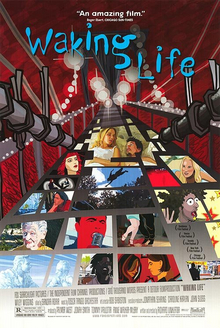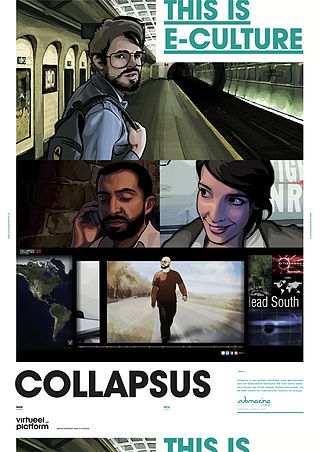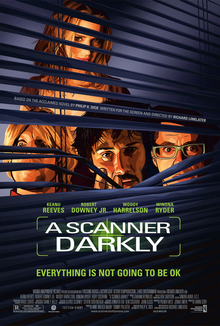
Keanu Charles Reeves is a Canadian actor. Born in Beirut and raised in Toronto, he made his acting debut in the Canadian television series Hangin' In (1984), before making his feature film debut in Youngblood (1986). Reeves had his breakthrough role in the science fiction comedy Bill & Ted's Excellent Adventure (1989), and he reprised his role in its sequels. He gained praise for playing a hustler in the independent drama My Own Private Idaho (1991) and established himself as an action hero with leading roles in Point Break (1991) and Speed (1994).

A Scanner Darkly is a science fiction novel by American writer Philip K. Dick, published in 1977. The semi-autobiographical story is set in a dystopian Orange County, California, in the then-future of June 1994, and includes an extensive portrayal of drug culture and drug use. The novel is one of Dick's best-known works and served as the basis for a 2006 film of the same name, directed by Richard Linklater.

Waking Life is a 2001 American animated film written and directed by Richard Linklater. The film explores a wide range of philosophical issues, including the nature of reality, dreams and lucid dreams, consciousness, the meaning of life, free will, and existentialism. It is centered on a young man who wanders through a succession of dreamlike realities wherein he encounters a series of people who engage in insightful philosophical discussions.

Rotoscoping is an animation technique that animators use to trace over motion picture footage, frame by frame, to produce realistic action. Originally, live-action movie images were projected onto a glass panel and traced onto paper. This projection equipment is referred to as a rotoscope, developed by Austrian-American animator Max Fleischer. This device was eventually replaced by computers, but the process is still called rotoscoping.

Richard Stuart Linklater is an American film director, producer, and screenwriter. He is known for making films that deal thematically with suburban culture and the effects of the passage of time. His films include the comedies Slacker (1990) and Dazed and Confused (1993); the Before trilogy of romance films: Before Sunrise (1995), Before Sunset (2004), and Before Midnight (2013); the music-themed comedy School of Rock (2003); the adult animated films Waking Life (2001), A Scanner Darkly (2006), and Apollo 10 1⁄2: A Space Age Childhood (2022); the coming-of-age drama Boyhood (2014); and the comedy film Everybody Wants Some!! (2016).
Bob Sabiston is an American film art director, computer programmer, and creator of the Rotoshop software program for computer animation. Sabiston began developing software as an undergraduate and then graduate researcher in the MIT Media Lab from 1986 to 1991. While at MIT, and also after moving to Austin, Texas, in 1993, Sabiston used his 2D/3D software to create several short films, including God's Little Monkey (1994), "Beat Dedication" (1988), and "Grinning Evil Death" (1990). "Grinning Evil Death" was widely seen on the first episode of MTV's "Liquid Television" show. "God's Little Monkey" won the Prix Ars Electronica Golden Nica award for 1994.
Rotoshop is a proprietary graphics editing program created by Bob Sabiston.
Tommy Pallotta is an American film director and producer.
Marco Perella is an American character actor and author, who has played a variety of small roles in motion pictures shot in Texas.

Life Is Cool is a 2008 South Korean romance animated film, and is the first rotoscoped film from that country. This film's visual style was influenced from Richard Linklater's two films, Waking Life (2001) and A Scanner Darkly (2006).
Dean Hsieh is an American artist, writer, and animator.

Collapsus is a project that combines animation, interactive fiction, and documentary film. This story follows how the impending energy crisis affects ten young people, while international powers battle with political dissension and a fearful population during transition from Fossil fuel to alternative fuels. Set in the near future, Collapsus was initialized to raise awareness of the global issue of peak oil.

Bill & Ted's Excellent Adventures is a 1990 animated television series spin-off from the 1989 film Bill & Ted's Excellent Adventure. It follows the titular protagonists, dimwitted teenage musicians Bill and Ted, who are visited by Rufus, a man from the future, who needs them to graduate from high school to start a rock band that inspires the people of the future. They travel to various time periods, making sure that history happens as it should, more or less.

6 Point Harness is an American animation studio and production label of Mondo Media based in Los Angeles. It develops and produces animated television programming, feature films, commercial, music videos and web-based content. Founded by Brendan Burch in 2003, some of the studio's most notable productions include Tom Hanks' Electric City, Fox's Cosmos: A Spacetime Odyssey, MTV's Good Vibes, Nick Jr.'s Wow! Wow! Wubbzy!, Nickelodeon's El Tigre: The Adventures of Manny Rivera, Adult Swim's Apollo Gauntlet and Lazor Wulf, the animated feature The Drawn Together Movie: The Movie!, and the web series Dick Figures for the YouTube channel Mondo Media. 6PH also released Dick Figures: The Movie, an in-house production developed from the company's web series.
Jason Archer and Paul Beck are a team of American music video directors, and animators. They specialize in the animation rotoscoping technique which have been used on their work for the films Waking Life and A Scanner Darkly. Archer and Beck also directed music videos for several performers including David Byrne, Juanes and Molotov. The duo won a Latin Grammy Award for Best Short Form Music Video at the Latin Grammy Awards of 2003 for "Frijolero".

Robert Downey Jr. is an American actor who has starred in numerous films, and television series. Downey made his acting debut in his father's film Pound at the age of five. In the 1980s, Downey was considered a member of the Brat Pack after appearing in the films Weird Science with Anthony Michael Hall (1985), Less than Zero with Andrew McCarthy (1987), and Johnny Be Good again with Hall (1988). Downey also starred in the films True Believer (1989) and Chances Are (1989), and was a regular cast member on the late-night variety show Saturday Night Live in 1985.

Keanu Reeves is a Canadian actor who has appeared in films, television series and video games. He made his film debut in the short One Step Away in 1985. The following year, Reeves appeared in the crime film River's Edge, and the television films Babes in Toyland, Act of Vengeance, and Brotherhood of Justice. His first lead role was as a teenager dealing with his best friend's suicide in the 1988 drama Permanent Record. His breakthrough role came when he played time-travelling slacker Ted "Theodore" Logan in the science fiction comedy Bill & Ted's Excellent Adventure (1989) with Alex Winter, which was an unexpected commercial success. Reeves followed this with a supporting role in Ron Howard's comedy Parenthood. In 1991 he starred in the action film Point Break with Patrick Swayze, the science fiction comedy sequel Bill & Ted's Bogus Journey, and the independent drama My Own Private Idaho.
Jason Archer is an American artist living in Austin, Texas. He is the creator of a variety artworks as a director, animator, painter, and muralist both collaborative and solo. His work includes political satire and Texas inspired characters including Jesus Cornbread & the Alcoholics and Stray of the Dead. Archer’s early career in animation earned him a Grammy and an MTV Video of the Year Award for directing and animating "Frijolero", a music video for the Mexican rock band Molotov. Currently, Archer co-owns Show Goat Mural Works, a company that installs large scale murals such as Daniel Johnston’s ‘Love is the Question. Love is the Answer’ and his very own ‘Conservatorium of Infinite Wisdom, Sustenance and Guidance.’ Archer has participated in numerous art shows, exhibitions and events ranging from SXSW, East Austin Studio Tour and the inaugural Pop Austin International Art Show.

Apollo 10½: A Space Age Childhood is a 2022 American animated coming of age comedy-drama film set during the events preceding the Apollo 11 Moon landing, loosely based on the childhood of writer, director, and producer Richard Linklater. It presents a fictional tale of a fourth-grader who becomes the first person to land on the Moon and stars Glen Powell, Jack Black, Zachary Levi and Josh Wiggins.
Arthouse animation is a combination of art film and animated film.












